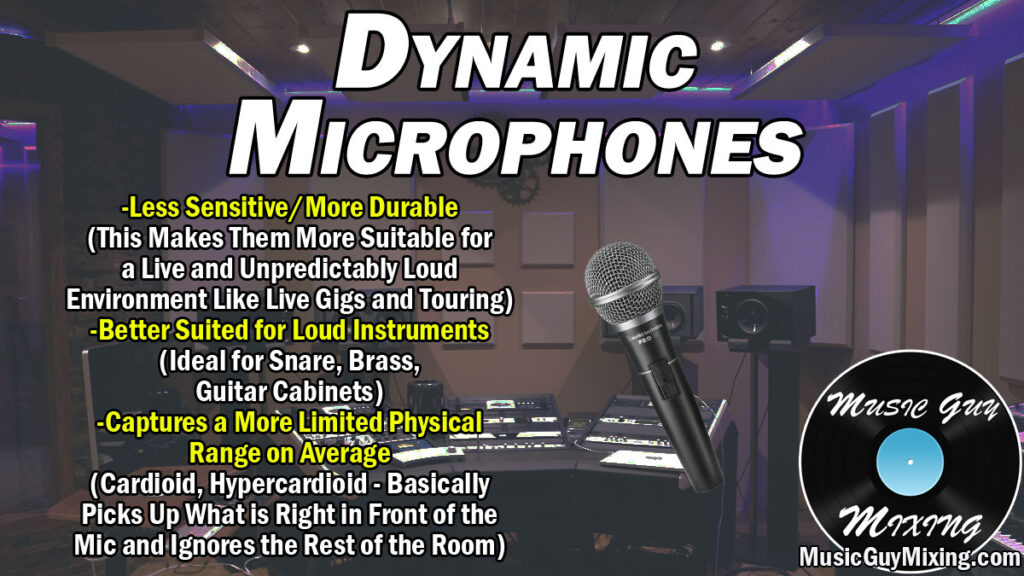Condenser and dynamic microphones are the two main types of microphones used in audio recording and production. Each option comes with its own characteristics and advantages for particular scenarios. While condenser microphones are typically better suited for quieter, studio level/home recording and dynamic microphones for capturing audio in live situations, there’s a lot more to it. Let’s delve into a detailed comparison of condenser vs dynamic microphones.
Condenser Vs Dynamic Microphones

Let’s talk about each one individually and how it differs from the other, beginning with dynamic microphones.
Dynamic Microphones
Dynamic microphones have a diaphragm attached to a coil of wire which sits within a magnetic field. Electrical signals in the coil are generated by this magnetic field when sound waves cause the diaphragm to vibrate, capturing sound.

Dynamic microphones have a relatively lower sensitivity and as such a higher gain threshold.
This means when they’re recording audio, they can withstand a much louder signal, or more sound pressure level (SPL) than a condenser microphone can which is much more sensitive by comparison.
Instruments which are inherently louder, like a snare drum, most brass instruments, even a loud vocalist – really anything which doesn’t have a volume control on it (though they’re ideal on a loud guitar amplifier, as well) are better suited being recorded with a condenser microphone.
With that much higher ceiling, there’s little risk of damaging the microphone.
This is also why you typically see dynamic microphones on stage for live shows where acoustics, feedback, and the general atmosphere are all much louder and less predictable.
Dynamic microphones are simply also more physically durable, so they can take a beating from a live show and all the travel that goes along with it.
The SM57 is the gold standard in affordable dynamic microphones, and it’s been used to record snares, hi-hats, guitars/bass – anything with an amplifier and cabinet for decades now.

Condenser Microphones

Condenser microphones utilize a diaphragm placed close to a backplate which forms a capacitor. They convert sound into electrical signals through changes in capacitance (the scientific explanation).
Condenser microphones are also better suited for a much more controlled environment like the studio (on certain instruments, at least).
They’re more sensitive, capable of capturing a greater dynamic and frequency range then dynamic microphones. As such, condenser microphones more accurately reproduce the subtle dynamic changes and frequency complexities of certain instruments.
This makes condenser microphones ideal for most vocals, acoustic guitar (see my complete guide on how to record acoustic guitar), and piano to name a few.
Condenser microphones also work well for recording an entire room. While a room can get loud when multiple performers are playing, as long as the condenser microphone isn’t right up on any of these sources which you’re recording then it should be fun.
Note that condenser microphones oftentimes need phantom power from your recording hardware.
Side note – when connecting a microphone which requires phantom power, make sure the Phantom Power/48V button is off and gain is all the way down (a good rule of thumb for connecting any microphone). Insert the XLR cable, initiate Phantom Power, then turn up the gain to the desired level (ideally averaging -18dB as per my gain staging cheat sheet).
When you’re done with the microphone, do the steps in the reverse, turning the gain all the way down, deactivating Phantom Power, and finally unplugging the microphone.
Never plug a microphone in with the gain up and Phantom Power on as this can damage the microphone.
To sum up, condenser microphones often yield better results, but their sensitivity leaves them vulnerable and unsuited for recording certain instruments and environments. Even if it doesn’t damage the microphone, feeding too much signal in to a condenser microphone makes it more likely to cause distortion in the recording.
As far as affordable condenser microphones go, the AT2035 is an excellent entry level condenser microphone for capturing vocals, acoustic guitar, really anything you throw at it, and it’s one I still use in my arsenal today.

Dynamic microphones have their limitations in generally not being as able to capture a signal as faithfully as a condenser microphone, but you can throw a lot more at them, making them the only suitable choice for louder instruments, particularly those you want to record up close.
Both microphone types have their uses and if you plan on recording a variety of instruments, you’d be well served having one or more of each type in your microphone arsenal.
One last thing to mention, make sure you know the difference between various microphone patterns.
Many condenser (and the occasional dynamic) microphones record in a different orientation than the standard “records what’s in front of it” pattern, the cardioid pattern.
This is by far the most prevalent polar pattern and the most useful for recording, but some microphones are designed to pick up a larger or better said wider range.
There’s a partial misconception that condenser microphones pick up more room sounds due to their increased sensitivity.
While this plays into it, a lot of this goes back to the polar patterns of microphones, with dynamic microphones are typically more narrow in their response range.
In other words, they’re blocking out anything they’re not pointed at, whereas most condenser microphones have a slightly wider range, thus picking up more of the room.
Condenser Vs Dynamic Microphones Compared
In summary, the choice between a condenser and dynamic microphone depends on your specific needs and the context of your recording or performance.
Condenser microphones offer superior sound quality but require a controlled environment, careful handling, and aren’t suitable for all instruments.
Conversely, dynamic microphones are robust and versatile, making them ideal for a range of live sound and high-pressure recording situations.
